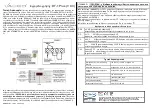
Register Descriptions
191
SLAU723A – October 2017 – Revised October 2018
Copyright © 2017–2018, Texas Instruments Incorporated
JTAG Interface
3.5.1.1
EXTEST Instruction
The EXTEST instruction is not associated with its own Data Register chain. Instead, the EXTEST
instruction uses the data that has been preloaded into the Boundary Scan Data Register using the
SAMPLE/PRELOAD instruction. When the EXTEST instruction is present in the Instruction Register, the
preloaded data in the Boundary Scan Data Register associated with the outputs and output enables are
used to drive the GPIO pads rather than the signals coming from the core. With tests that drive known
values out of the controller, this instruction can be used to verify connectivity. While the EXTEST
instruction is present in the Instruction Register, the Boundary Scan Data Register can be accessed to
sample and shift out the current data and load new data into the Boundary Scan Data Register.
3.5.1.2
SAMPLE/PRELOAD Instruction
The SAMPLE/PRELOAD instruction connects the Boundary Scan Data Register chain between TDI and
TDO. This instruction samples the current state of the pad pins for observation and preloads new test
data. Each GPIO pad has an associated input, output, and output enable signal. When the TAP controller
enters the Capture DR state during this instruction, the input, output, and output-enable signals to each of
the GPIO pads are captured. These samples are serially shifted out on TDO while the TAP controller is in
the Shift DR state and can be used for observation or comparison in various tests.
While these samples of the inputs, outputs, and output enables are being shifted out of the Boundary
Scan Data Register, new data is being shifted into the Boundary Scan Data Register from TDI. Once the
new data has been shifted into the Boundary Scan Data Register, the data is saved in the parallel load
registers when the TAP controller enters the Update DR state. This update of the parallel load register
preloads data into the Boundary Scan Data Register that is associated with each input, output, and output
enable. This preloaded data can be used with the EXTEST instruction to drive data into or out of the
controller. See
for more information.
3.5.1.3
ABORT Instruction
The ABORT instruction connects the associated ABORT Data Register chain between TDI and TDO. This
instruction provides read and write access to the ABORT Register of the Arm DAP. Shifting the proper
data into this Data Register clears various error bits or initiates a DAP abort of a previous request. See the
for more information.
3.5.1.4
DPACC Instruction
The DPACC instruction connects the associated DPACC Data Register chain between TDI and TDO. This
instruction provides read and write access to the DPACC Register of the Arm DAP. Shifting the proper
data into this register and reading the data output from this register allows read and write access to the
Arm debug and status registers. See
for more information.
3.5.1.5
APACC Instruction
The APACC instruction connects the associated APACC Data Register chain between TDI and TDO. This
instruction provides read and write access to the APACC Register of the Arm DAP. Shifting the proper
data into this register and reading the data output from this register allows read and write access to
internal components and buses through the Debug Port. See
for more information.
3.5.1.6
IDCODE Instruction
The IDCODE instruction connects the associated IDCODE Data Register chain between TDI and TDO.
This instruction provides information on the manufacturer, part number, and version of the Arm core. This
information can be used by testing equipment and debuggers to automatically configure input and output
data streams. IDCODE is the default instruction loaded into the JTAG Instruction Register when a Power-
On-Reset (POR) is asserted, or the Test-Logic-Reset state is entered. See
for more
information.
















































